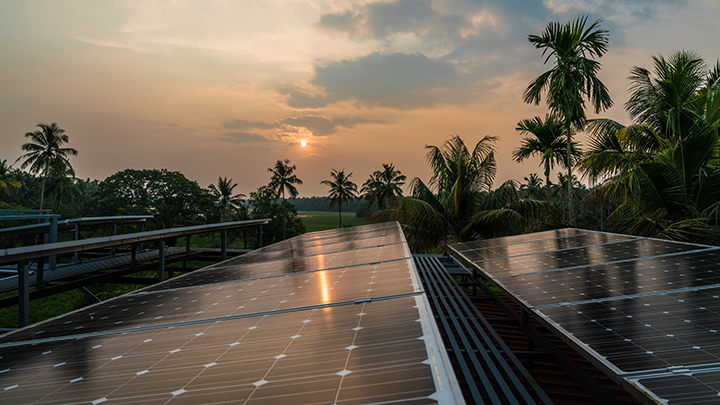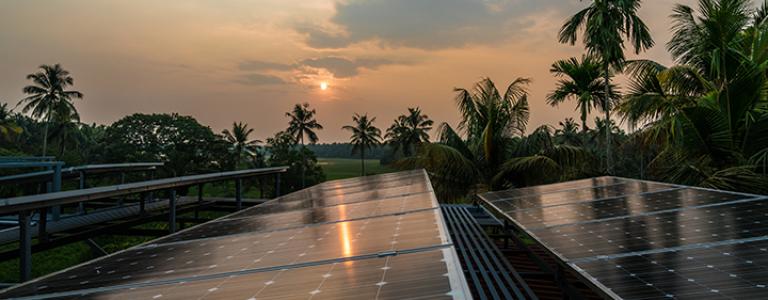Is GST stalling India's clean energy transition?
Is a newly introduced Goods and Sales Tax stalling India's move away from fossil fuels toward renewable energy?
India, the world’s third-largest energy consumer is undergoing a clean energy transition.
This transition must not only advance climate commitments but also development needs and economic priorities. This is a delicate balancing act. As we tread this tightrope, introduction of new macroeconomic policies could add further complexities.The goods and services tax (GST), introduced in July 2017, is one such example. The GST removed tax exemptions offered previously to solar photovoltaic (PV) and added much uncertainty during the first year of its introduction. How has the GST implementation impacted the cost of solar PV power?

According to a recent study published by the Council on Energy, Environment and Water (CEEW) and the International Institute for Sustainable Development (IISD), the introduction of GST has led to an increase in cost of generation of solar power by almost 6 per cent, while simultaneously reducing the cost of coal-based thermal power by nearly 2 per cent for existing plants.
Overall, it appears that the GST has implicitly widened the gap between coal-based power and solar PV, which has otherwise narrowed in the past few years, and could delay the onset of much needed ‘parity’ between the two sources. Combined with the imposition of safeguards duty (making majority of the PV panels used expensive) and the cap on solar power tariffs, the GST impact may have a bearing on profitability of companies in the sector.
Renewables deserve preferential treatment
The utility-scale solar power projects have become increasingly cost competitive against conventional energy sources. The scaling back of tax exemptions for solar PV under the GST regime and plans to further reduce subsidy support to renewables, suggests that the sector has already achieved critical mass to compete on its own merit.
Yet, it is also important to recognise that segments such as rooftop solar, microgrids, offshore wind, and floating solar continue to remain expensive or are too nascent to be deployed without adequate support in the short- and mid-term. The National Clean Energy and Environment Fund (NCEF), fed by the Clean Environment Cess applied on coal, was earmarked for supporting clean energy technology research and projects. With the GST, the Clean Environment Cess has been replaced with the GST Compensation Cess, which is no longer directed into the NCEF. This void must be plugged by the government through an alternative source. Policymakers should distinguish between emerging and mature renewable energy technologies and extend continued support to nascent but critical alternatives.
Another distinction that the GST regime must make is between the variety of contracting structures that exist for solar PV. According to a recent notification by the GST Council, 70 per cent of the gross value of the contract will attract 5 per cent GST, while the remaining 30 per cent will be treated as services and attract 18 per cent GST. This approach seems arbitrary since, for instance, the share of services in solar parks projects is close to 17 per cent. Ideally, services associated with installation of solar PV must be part of a composite supply and attract 5 per cent GST just as the solar power generating system.
It is also worth noting that the above clarification from the GST Council came after more than a year of implementation of GST. Until then, there was confusion on the GST rates applicable for solar power projects, with states differing from each other in their interpretation. The introduction of the safeguards duty on solar panels has only compounded the uncertainty, resulting in delays in deployment of solar projects.
The GST must increase relative competence of solar power with due consideration to second-order effects. One could argue that taxation on coal must reflect the health and environmental costs it imposes on the society but a higher tax on coal would make energy unaffordable for economically vulnerable groups. Hence, policymakers must focus on targeted subsidies, just as those being provided for LPG consumption under the Ujjwala scheme, to ensure that benefits accrue to the deserving, while also pursuing decarbonisation of India’s energy sector. Further, it is also important to evaluate the net impact of fiscal measures and budgetary support on promoting sustainable energy choices.

The GST was introduced with the intention of simplifying indirect taxes and reining in inefficiencies in the tax system. It is not surprising for a major shift in fiscal policy to have unintended consequences, which will be resolved over time. However, it is important to continuously monitor and examine if such fiscal measures are being effectively wielded, to support India’s larger national objectives with implications for sustainable development.
This article first appeared on Energyworld from The Economic Times on March 8, 2019.
You might also be interested in
G20 energy ministers call for cooperation on nuclear energy & low-emission hydrogen
The Group of 20 energy ministers' meeting concluded in Goa on July 22, 2023, with the final summary failing to include language on the phase-down of unabated fossil fuels.
Fighting for a place to breathe
In the shadow of a retired coal-fired power plant in India's capital, Meena Devi tries to make her family home -- four brick walls with a tin roof -- a safe place to breathe.
Subsidies for renewable energy and EVs more than double: Study
Nagpur: India’s subsidies for renewable energy and electric vehicles more than doubled this fiscal, according to a new study by independent think-tank International Institute for Sustainable Development (IISD). However, it also found that it will be critical for the government to build this momentum over the coming years to reach the country's climate targets.
EV subsidies in India doubled in FY 2022: IISD report
According to a recent study conducted by IISD (International Institute for Sustainable Development) subsidies for renewable energy and EVS in India have more than doubled in FY 2022. India still allocated four times more support to fossil fuels than clean energy, although the gap narrowed significantly since FY 2021 when support was nine times greater.
